Tuesday, 14 May 2013: Aix on foot
Written Tuesday, 21 May 2013
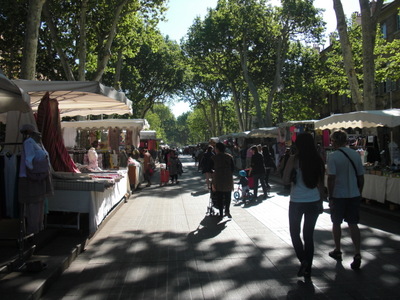
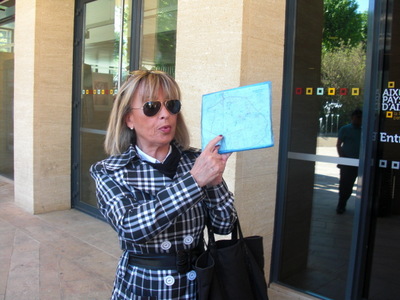 We had reserved for the two-hour walking tour for Tuesday morning, but when the time came, it was just too early in the morning for David, especially given that it would take most of half an hour just to walk to the Office de Tourisme, where the tour started. So he begged off, and I went by myself.
We had reserved for the two-hour walking tour for Tuesday morning, but when the time came, it was just too early in the morning for David, especially given that it would take most of half an hour just to walk to the Office de Tourisme, where the tour started. So he begged off, and I went by myself.
I found the Cour Mirabeau filled with a clothing, shoe, and fabric market, which I strolled the whole length of on the way. The fabric stalls had both Provençal cloth by the yard and ready-made items, mainly tablecloths, placemats, bread baskets, pot holders, hand and dish towels, and little zippered cases of various sizes and shapes. The patterns of the cloth were of two sorts: bold prints in bright colors of Provençal motifs (tomatoes, olives, sunflowers) and prints based on small paisley patterns (brought to this area surprisingly early from India).
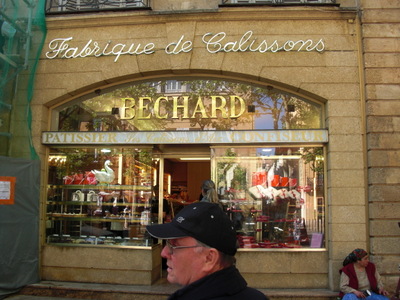
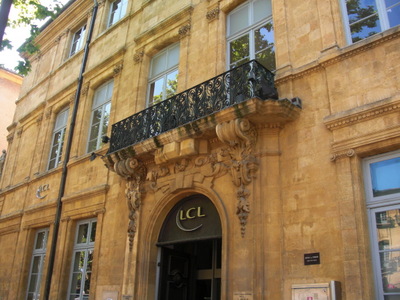 Our guide for the morning was Stella (shown on the right above), and once again she proved an absolute mine of information. Actually, more like a fountain of information; you definitely didn't have to dig for it! Much of the background I've already written up actually came from this tour
Our guide for the morning was Stella (shown on the right above), and once again she proved an absolute mine of information. Actually, more like a fountain of information; you definitely didn't have to dig for it! Much of the background I've already written up actually came from this tour
One of the first things we came to was a major calisson maker, so she started with that. She told us, among many other things, that on the first Sunday of September every year, a grand judging of callisons is held and that, on that one occasion, you have the chance to sample the products of every calisson maker in town.
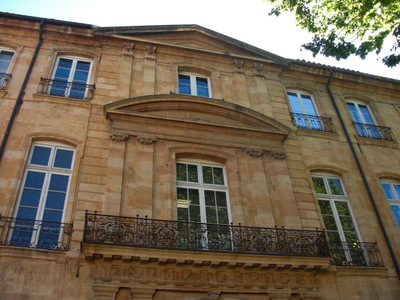
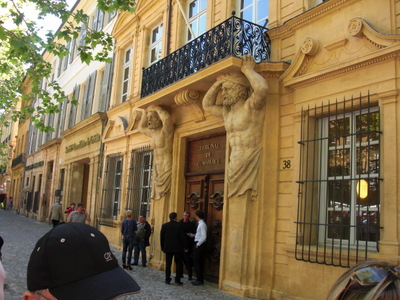 From there, she branched heavily into architecture, pointing out all the features, large and small, that the owners used to show off their wealth. In the photo to the right (the one with LCL), above, the most interesting feature for me was the three blank stones over the door, which she said were referred to as "en attente," that is, waiting for the owner to get together the money to have them carved into something more decorative. Apparently, this one never made it.
From there, she branched heavily into architecture, pointing out all the features, large and small, that the owners used to show off their wealth. In the photo to the right (the one with LCL), above, the most interesting feature for me was the three blank stones over the door, which she said were referred to as "en attente," that is, waiting for the owner to get together the money to have them carved into something more decorative. Apparently, this one never made it.
Written Wednesday, 22 May 2013
In this pair, the photo on the left illustrates the ostentatious use of different pediments above the windows on different floors. I thik the capitals of the pilasters also progress form Doric to Ionian to Corinthian. The one on the right illustrates the entryway of the most pretentious mansion on the Cour Mirabeau. Stella told us that the avenue was so socially stratified that different classes of nobility (was it military versus religious? I forget) walked on different sides of the street and social class also determined how far one could walk from the gutter. The merchant who wanted to build this mansion couldn't, because he was
Many of the mansions were built twice as big as necessary, both for ostentation and so that the residents could move into the north-facing rooms in summer (for coolness) and across the hall into the south-facing ones in winter (for sun).
Stella assured us that Aix has no Roman structures or even ruins left—all have been demolished or cannibalized to the ground for building stone. The Romans used other stone for building and shipped the golden stone from the local quarry to be used in more prestigious locations, but the major building boom in the 17th century used the local stone exclusively. Now (beginning in the 19th century, I think) the quarries were closed because the high-quality stone was played out and its production began to have increasing numbers of balls of calcareous stone embedded in it. Modern buildings that hope to match the old one have to paint or tint their stone, usually to a shade a little too orange.
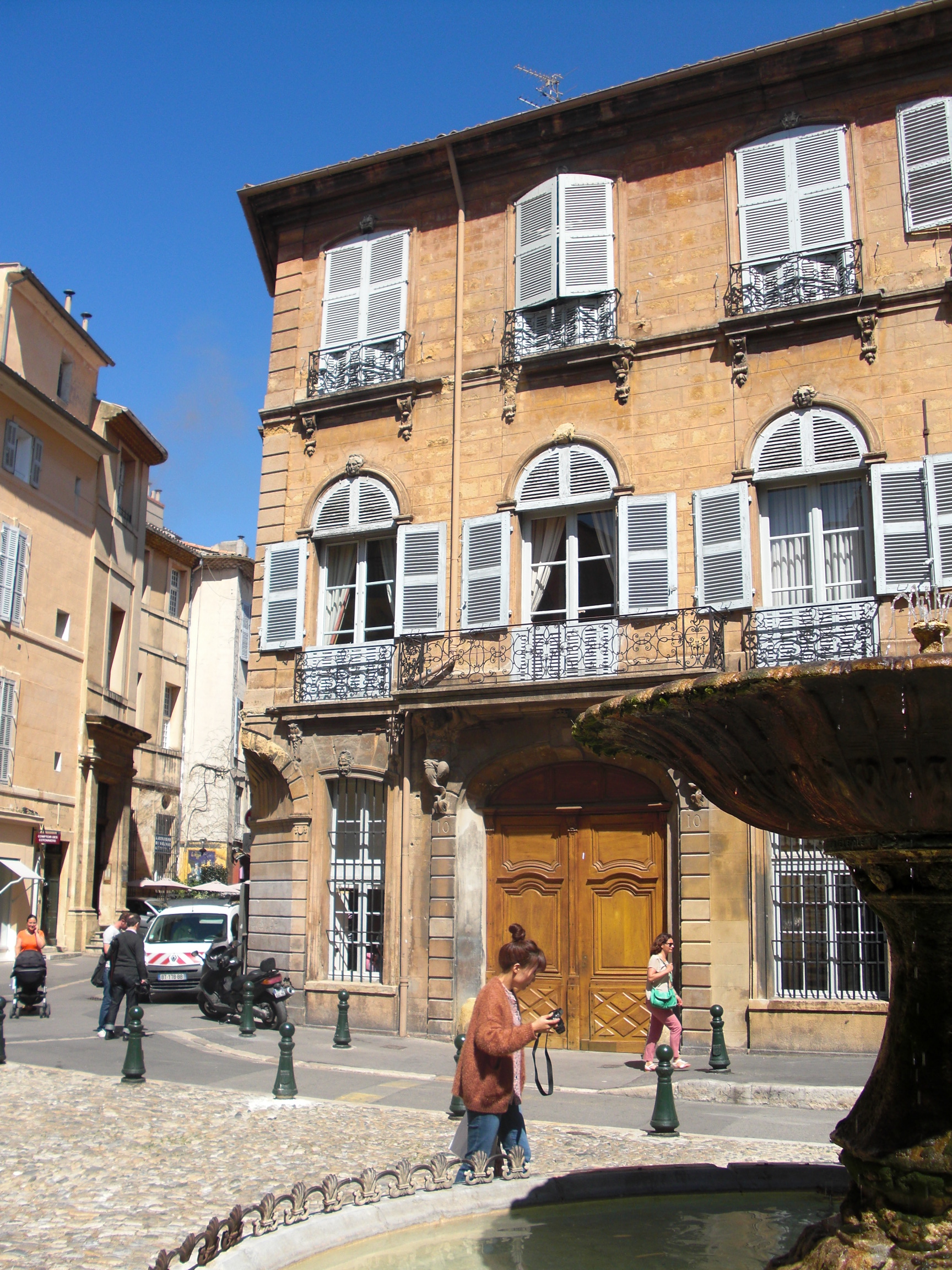
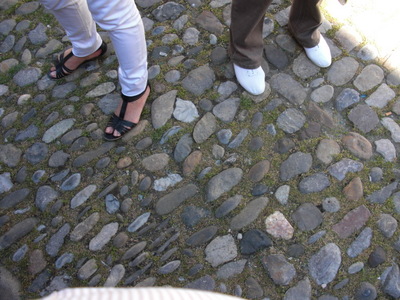 All those grandiose 17th- and 18th-century houses on the Cour Mirabeau and the Quartier Mazarin left the really old aristocracy of Aix in a quandary. We were shown the mansion of one house in particular (at left) that, being stuck in the center of the old town, couldn't expand and didn't have a sunny avenue in front. The family who had lived there for generations (and still does today) could not possibly lower themselves by moving to mix with the masses building new houses, so instead they redid their facade in more ornate style, then bought the large house across the street, demolished it, and installed a handsome little square of their own. For additional sumptuousness, they made the corners of the square rounded and installed a good-sized fountain in the center.
All those grandiose 17th- and 18th-century houses on the Cour Mirabeau and the Quartier Mazarin left the really old aristocracy of Aix in a quandary. We were shown the mansion of one house in particular (at left) that, being stuck in the center of the old town, couldn't expand and didn't have a sunny avenue in front. The family who had lived there for generations (and still does today) could not possibly lower themselves by moving to mix with the masses building new houses, so instead they redid their facade in more ornate style, then bought the large house across the street, demolished it, and installed a handsome little square of their own. For additional sumptuousness, they made the corners of the square rounded and installed a good-sized fountain in the center.
They sloped the square slightly toward the street and paved it with "calades"—large, flat river pebbles set on edge in a bed of sand. Mud was a major problem in city streets in those days, but calades drained well, both down between the pebbles and down the slope into the gutters. Stella pointed out that you could tell this particular area of calades was authentic and of the period, because moss and grasses grew in the spaces between the stones. Nice, clean, vegetation-free calades are modern fakes in which the pebbles are set in concrete rather than sand.
Our walk also took us through two different markets, in addition to the one on Cour Mirabeau.
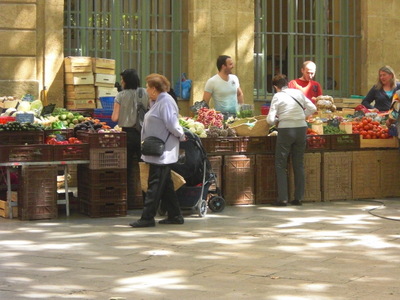
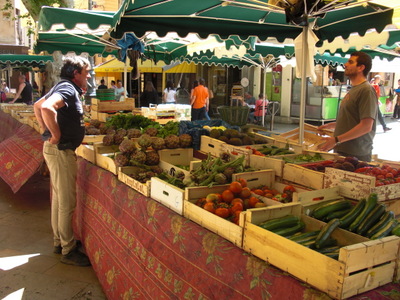 The one here was all food, mostly fruits and vegetables but some meat and cheese. Artochokes are in season just now, both green and purple and both large and small. We've been served them several times, most often paired with seafood. Note also the colorful Provençal print fabric the tables are draped with.
The one here was all food, mostly fruits and vegetables but some meat and cheese. Artochokes are in season just now, both green and purple and both large and small. We've been served them several times, most often paired with seafood. Note also the colorful Provençal print fabric the tables are draped with.
This market is here every day, every morning until about 1 p.m. As soon as it is cleared away, all the cafés surrounding the square immediately put their tables and chairs out and occupy all the space for the convenience of late lunchers.
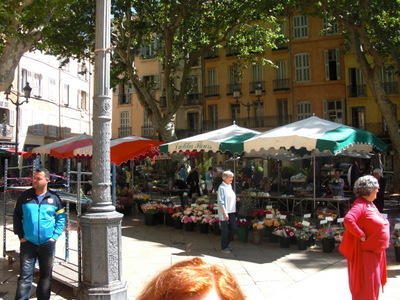
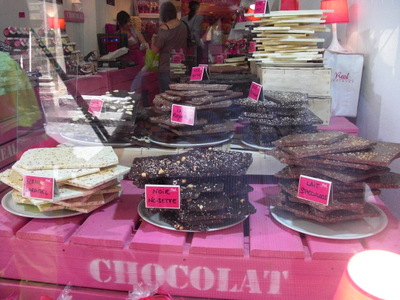 The other market was flowers, mostly the cut flowers you see here but also bedding plants, vegetable plants, potted plants, and even landscaping plants.
The other market was flowers, mostly the cut flowers you see here but also bedding plants, vegetable plants, potted plants, and even landscaping plants.
In passing, I couldn't resist taking a photo of this chocolate-shop window, stocked with slabs of chocolate, white, milk, and dark, all flavored and/or studded with other stuff (hazelnuts, caramel bits, mint, pistachios, banana chips, crumbled speculoos cookies. All presumably sold by the pound and, as many shop windows continuously announce, French Mother's Day is coming.
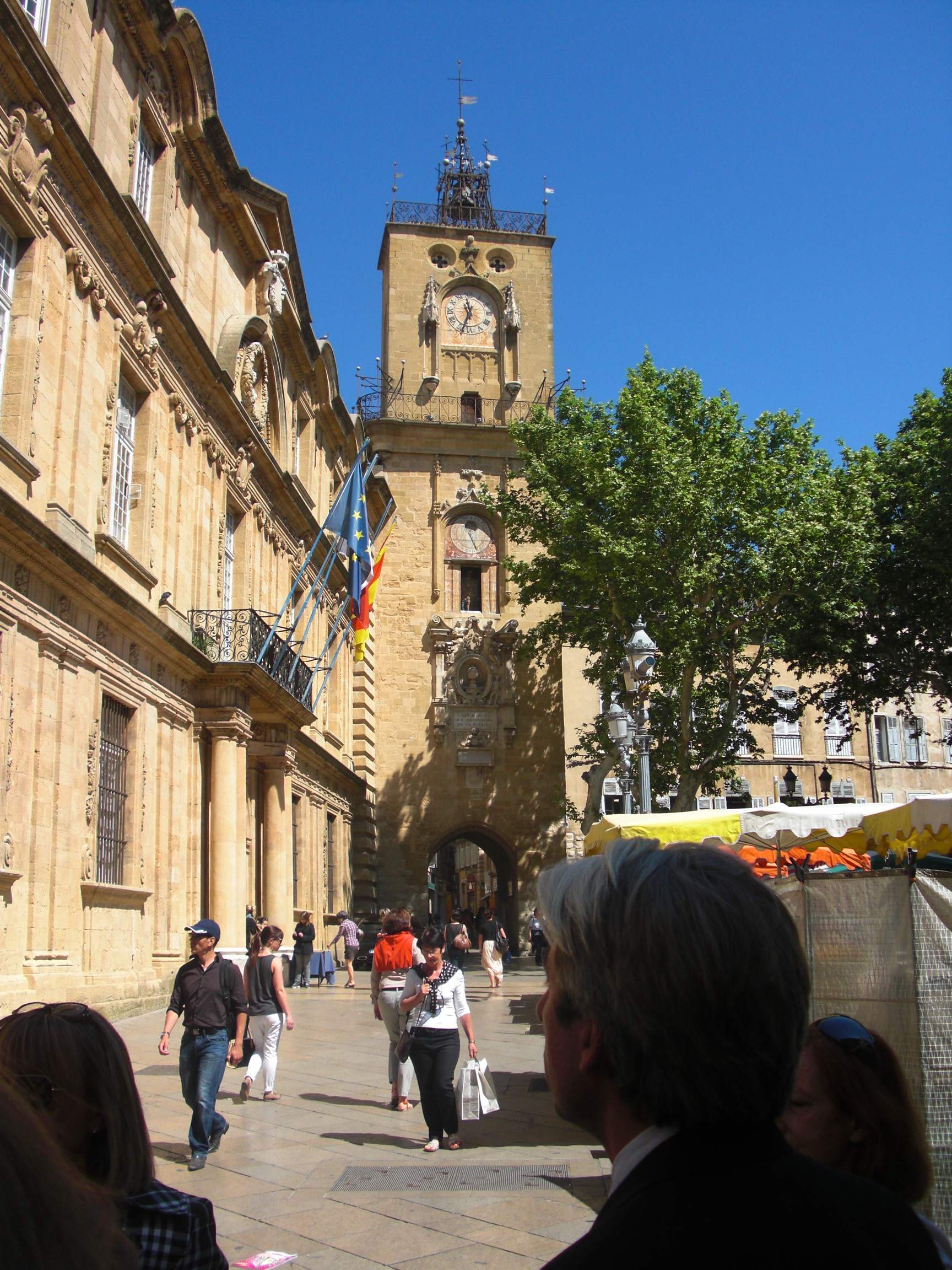
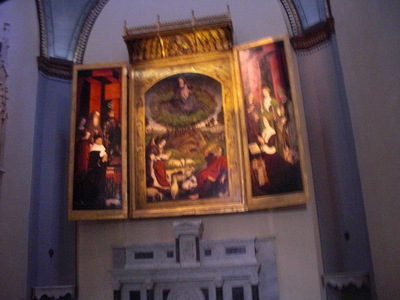 Just above the flower market was the town's clock tower , begun in 1510, somewhat after the first university in town was opened in 1409. The university is just across a square (beyond the clock tower) from the cathedral, which was begun in the 5th century. Its architecture incorporates romanesque, gothic, and baroque styles, and some of the altar furniture is 20th century, so Stella was proud to point out that it illustrates 2000 years of architecture in one building.
Just above the flower market was the town's clock tower , begun in 1510, somewhat after the first university in town was opened in 1409. The university is just across a square (beyond the clock tower) from the cathedral, which was begun in the 5th century. Its architecture incorporates romanesque, gothic, and baroque styles, and some of the altar furniture is 20th century, so Stella was proud to point out that it illustrates 2000 years of architecture in one building.
The cathedral's crowning jewel is the triptyque of the burning bush, shown here on the right. Its recent restoration took eight years, at least partly because Aix wouldn't let it out of the building, let alone out of the city, lest the Louvre try to snaffle it—they apparently have nothing of this period by René d'Anjou's court painter, Nicholas Froment, illustrating both his Flemish (he was originally from Picardy) and his Italian training.
My photo is hopelessly blurry (you can't get close, and the light was dim), but you can see the layout. To the left and right, kneeling, are René (who was aging and commissioned the triptyque as what David calls "fire insurance"; he has even taken off his crown and laid in on the table in front of him) and his second wife, Jeanne de Laval, each surrounded by standing saints. In the center panel are the angel of the annunciation, Moses (astonished at the apparition), and the Virgin Mary with the Christ child. These two are sitting in the middle of the burning bush (the flames are very pale and hard to see, even in person and with binoculars). The bush has 12 trunks (12 tribes, 12 apostles, . . .), and everything else in the scene is heavily symbolic. The detail is amazing: I'm told that, with a magnifying glass, one can read the text in the book before Jeanne, and the Christ child is holding a little oval mirror in which he and his mother are reflected. For better images and explanations than mine, just Google "triptyque du buisson ardent Aix."
Other interesting things to see in the cathedral were the 6th-century baptismal font (total-immersion style) and the fake organ. The real organ is mounted high on the wall above one side of the choir, so for symmetry, a fake one adorns the opposite wall.
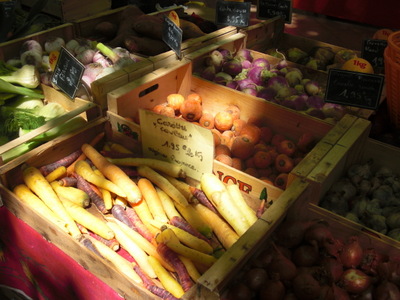
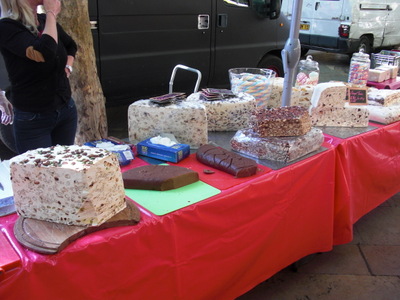 When I came back down the hill after end of the tour, the market was still in session. At the left is a great display of carrots. In front is a box of regular long carrots in a range of colors: orange, yellow, and purple. Behind them is a box of cute little spherical orange carrots.
When I came back down the hill after end of the tour, the market was still in session. At the left is a great display of carrots. In front is a box of regular long carrots in a range of colors: orange, yellow, and purple. Behind them is a box of cute little spherical orange carrots.
On the right is a display of nougat in a variety of flavors, made in large cylindrical loaves and sliced off to be sold by the pound. I don't know what the flat brown slabs are, but I would guess "pain d'epices." Near the umbrella pole is a large glass vase in which twisted ropes of soft marshmallow are coiled.
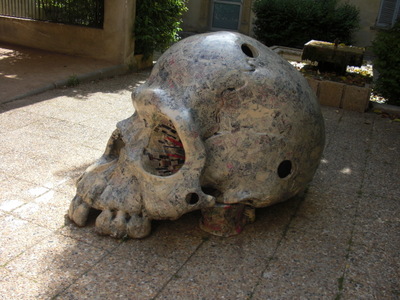
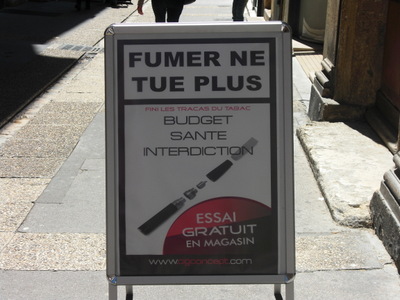 Also on the way down the hill, I caught a glimpse of what looked like a giant skull in an inner courtyard. Later, I took David back to have a look at it and to get this photo. It stands maybe three feet high and was one of several modern sculptures in the courtyard.
Also on the way down the hill, I caught a glimpse of what looked like a giant skull in an inner courtyard. Later, I took David back to have a look at it and to get this photo. It stands maybe three feet high and was one of several modern sculptures in the courtyard.
On the sidewalk, I found this remarkable poster that proclaims "Smoking no longer kills." It's an ad for one of those newfangled electrical tobacco-less cigarettes. You buy nicotine cartridges for it, and it delivers puffs of nicotine-loaded steam—in other words, the toxin you're addicted to without all the other toxins and particulates that damage your lungs. The poster touts is health benefits, economy, and value where smoking is forbidden. I've actually seen people around here puffing on them.
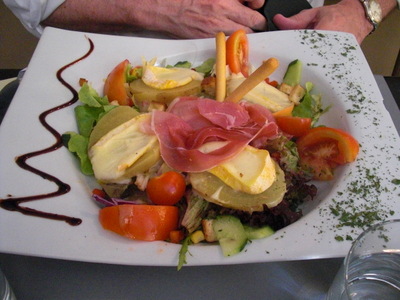
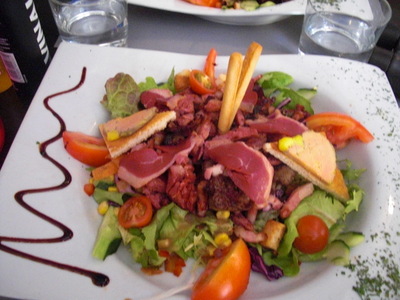 Back at the hotel, I collected David, and we found lunch at Le Bouddoir on the Cour Mirabeau. He had his usual Savoyard salad with goat cheese melted on toasts, plus ham, salad greens, tomato, cucumber, corn, and breadsticks.
Back at the hotel, I collected David, and we found lunch at Le Bouddoir on the Cour Mirabeau. He had his usual Savoyard salad with goat cheese melted on toasts, plus ham, salad greens, tomato, cucumber, corn, and breadsticks.
I had my usual Perigourdine, of the same salad mixture but topped with chicken livers and gizards, foie gras, slices of duck magret, and lardons.
On the way there, we were in time to catch the last of the fabric market and pick up a few gifts.
We spent most of the afternoon walking back over the area covered by the tour, while I repeated as much of Stella's spiel as I could remember, while it was still fresh in my mind.
Finally, we settled at a café to people-watch and rest our feet, over a decaf for David and a mineral water for me, before going back to the hotel to get ready for dinner.
Other interesting stuff I learned on the tour:
Aix was the capital of Provence from ancient times and, when it became part of France was designated the Prefecture (Eugène Delacroix's father was the fist prefect), until the 18th century (I think), when the prefecture was taken away and given to Marseille. Huge humiliation for the whole town. The population sank as low as 20,000 for a while afterwards, although today, it's up to 150,000, of which 40,000 are students.
All the fountains in Aix have very low rims around their lowest pools, by long-standing agreement with the sheep-herders who used to bring their flocks through town twice a year during the "transhumence"—the trip from summer to winter pasture and back. The fountains' sides could be no more than a "coudé" tall (the length of a forearm; is that a cubit?), so that the sheep could reach over them to drink. Today, the transhumence still takes place. The sheep are elaborately decorated, as tradition dictates, and they are paraded through several villages amid a festival atmosphere (popular with tourists) before being loaded onto trucks and whisked away to the appropriate seasonal pastures. They no longer walk through Aix, so the town has raised the rims of many of the fountains a little, so that they now form convenient public benches.
The three figures that top the 1860 fountain in the center of the Rotonde represent the three principal cities of Provence and their preoccupations: Marseille (agriculture), Aix (the law), and Avignon (the beaux arts). Aix is still heavily associated with the law. That first university is still a major law school, Aix is the second "court of appeals" after Paris, and several other universities have been founded, many of them specializing in law.
Marseille and Aix are two cities that "turn their backs on one another." Marseille is oriented toward the Mediterranean and "looks south." Aix is oriented toward Paris, administration, and law. And Aix is still mad about the prefecture thing.
When actor and singer Alain Delon stayed for a while in a house at the corner of the square with the fountain of the four dolphins, he had the ornamental basin in the interior courtyard made into a swimming pool (while of course retaining the rounded shape and historical ornamentation).
Finally, more about Le Bon Roi René (heavily cribbed from my 1999 Christmas letter, in which I described our visit to the Loire valley and Ren%eacute;'s castle in Angers:
"In Angers, the main attraction was Angers castle, home of René le Bon (i.e., the Good) (1409–1480), last Duke of Anjou (as well as Count of Aix-en-Provence, Duke of Bar, Duke of Lorraine, King of Naples, and titular king of Jerusalem and Aragon (including Sicily, Majorca, Corsica). The dynasty had been in the neighborhood for a good long time (Henry II of England was one of them, and the philandering Anjou that Elizabeth I of England doesn't marry in the movie Elizabeth was probably Rene's father or grandfather), built a number of heavily fortified castles (including Angers), and made a good deal of war over the years. But René was a poet, painter, musician, gardener, scholar (of languages, math, geology, law), and all-around nice guy. He was married twice (the first time, at age 12, to Isabella, Duchess of Lorraine, nine years his senior, and later to Jeanne de Laval, more than 20 years his junior), long and happily both times. He planted flower gardens (recently restored) in the castle mote, cultivated topiary and a whole zoo of exotic animals in the courtyard, commissioned music and tapestries, organized popular festivals for his subjects, and brought general prosperity to the region for several decades. Needless to say, the people adored him. Toward the end of his life, though, his cousin Louis XI of France annexed Anjou and told him to get out or be driven out militarily. Not wanting to put his subjects through a war, Rene took it philosophically, packed up his tapestries and his zoo, and moved to Aix, where he died at the ripe old age of 72. The little almond "callison" confections sold all over France as a specialty of Aix are still called "callisons du bon roi René"—they loved him there, too."
Alas, he was the last of his line, because none of his male issue survived him, and daughters couldn't inherit. Aix then passed to (who else) his cousin Louis XI, and the general feeling is that things just haven't been the same since. René is one of my all-time favorite historical figures. In The Da Vinci Code, Dan Brown made him grand master of that secret society he goes on about, from 1418 (when he was nine years old!) until his death in 1480, when he was succeeded by his daughter. You can Google up lots more information on him.
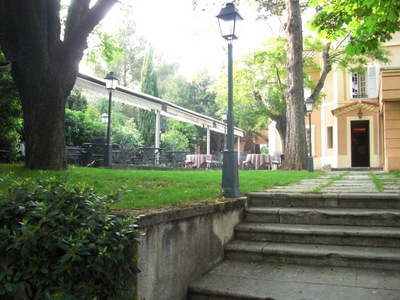
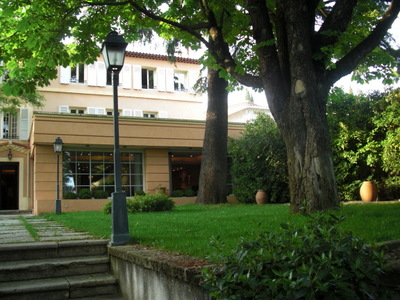 But I digress . . . Dinner was at Clos de la Violette (named not for the presence of violets but for the street it's located on), a few blocks outside the ring road north of town. We walked there, but by the end of dinner, it had started to rain, so we took a taxi back.
But I digress . . . Dinner was at Clos de la Violette (named not for the presence of violets but for the street it's located on), a few blocks outside the ring road north of town. We walked there, but by the end of dinner, it had started to rain, so we took a taxi back.
It was surrounded by good-sized, free-standing suburban houses, but it must have been there longer. Inside the imposing gates that faced the street was the lovely courtyard, shaded by big old honey locusts and horse chestnuts. Unfortunately, it was a little cool and damp to sit on the terrace.
Written Saturday, 25 May 2013
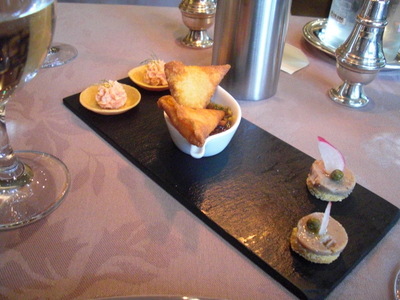
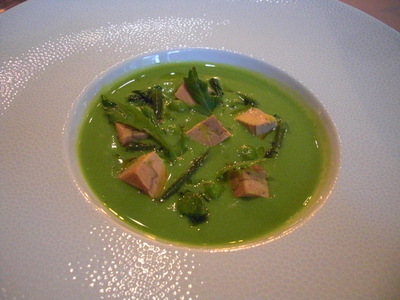 We chose the "Discovery Menu," so we both ate the same things.
We chose the "Discovery Menu," so we both ate the same things.
Amuse-bouche: Neat circles of bread topped with neat circles of some sort of pâté, tuna we think, garnished with radish and caper. Crispy fried triangles filled with some sort of meat mixture, accompanied by an Asian-influenced dipping sauce. Tiny tartlets of salmon mousse with dill sprigs. All good but not knock-your-socks-off.
First course: Creamy soup of fresh peas seasoned with mint (a common amuse-bouche this year, probably just because we're here in the traditional season for it), with a few whole peas, tiny green beans, cubes of cold foie gras, and a few leaves of arugula in it. Excellent soup, but the foie gras seemed superfluous.
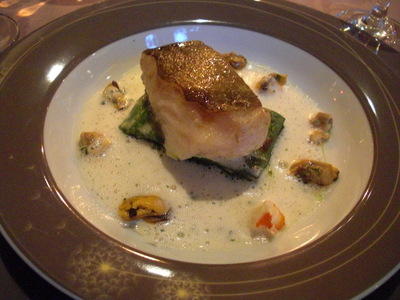
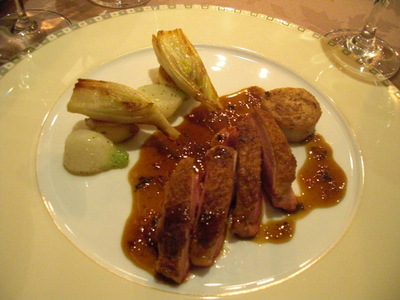 Second course: Perfectly cooked fresh cod on a bed of "herb lasagne"—a cooked herb mixture sandwiched between two sheets of bright green pasta—all surrounded by a frothy shellfish broth and little cooked cockles and mussels (not alive, alive, though), and bits of lobster. Great.
Second course: Perfectly cooked fresh cod on a bed of "herb lasagne"—a cooked herb mixture sandwiched between two sheets of bright green pasta—all surrounded by a frothy shellfish broth and little cooked cockles and mussels (not alive, alive, though), and bits of lobster. Great.
Third course: Duck roasted with marjoram, sautéed baby endives and turnips, and olive juices. The cylinder to the right of the duck, not mentioned on the menu, seemed to be polenta. Very yummy indeed.
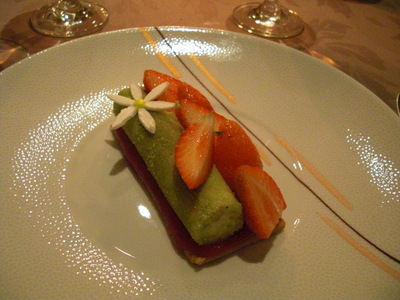 Dessert: Strawberries napped with a sweet strawberry sauce and a cylinder of "light pistachio cream" all on top of a rectangle of brown-sugar shortbread spread with a cooked strawberry mixture. The daisy is made of sugar. The gold streaks are part of the plate, but the narrow brown line between them is chocolate.
Dessert: Strawberries napped with a sweet strawberry sauce and a cylinder of "light pistachio cream" all on top of a rectangle of brown-sugar shortbread spread with a cooked strawberry mixture. The daisy is made of sugar. The gold streaks are part of the plate, but the narrow brown line between them is chocolate.
previous entry
List of Entries
next entry

 We had reserved for the two-hour walking tour for Tuesday morning, but when the time came, it was just too early in the morning for David, especially given that it would take most of half an hour just to walk to the Office de Tourisme, where the tour started. So he begged off, and I went by myself.
We had reserved for the two-hour walking tour for Tuesday morning, but when the time came, it was just too early in the morning for David, especially given that it would take most of half an hour just to walk to the Office de Tourisme, where the tour started. So he begged off, and I went by myself.
 Our guide for the morning was Stella (shown on the right above), and once again she proved an absolute mine of information. Actually, more like a fountain of information; you definitely didn't have to dig for it! Much of the background I've already written up actually came from this tour
Our guide for the morning was Stella (shown on the right above), and once again she proved an absolute mine of information. Actually, more like a fountain of information; you definitely didn't have to dig for it! Much of the background I've already written up actually came from this tour
 From there, she branched heavily into architecture, pointing out all the features, large and small, that the owners used to show off their wealth. In the photo to the right (the one with LCL), above, the most interesting feature for me was the three blank stones over the door, which she said were referred to as "en attente," that is, waiting for the owner to get together the money to have them carved into something more decorative. Apparently, this one never made it.
From there, she branched heavily into architecture, pointing out all the features, large and small, that the owners used to show off their wealth. In the photo to the right (the one with LCL), above, the most interesting feature for me was the three blank stones over the door, which she said were referred to as "en attente," that is, waiting for the owner to get together the money to have them carved into something more decorative. Apparently, this one never made it.
 All those grandiose 17th- and 18th-century houses on the Cour Mirabeau and the Quartier Mazarin left the really old aristocracy of Aix in a quandary. We were shown the mansion of one house in particular (at left) that, being stuck in the center of the old town, couldn't expand and didn't have a sunny avenue in front. The family who had lived there for generations (and still does today) could not possibly lower themselves by moving to mix with the masses building new houses, so instead they redid their facade in more ornate style, then bought the large house across the street, demolished it, and installed a handsome little square of their own. For additional sumptuousness, they made the corners of the square rounded and installed a good-sized fountain in the center.
All those grandiose 17th- and 18th-century houses on the Cour Mirabeau and the Quartier Mazarin left the really old aristocracy of Aix in a quandary. We were shown the mansion of one house in particular (at left) that, being stuck in the center of the old town, couldn't expand and didn't have a sunny avenue in front. The family who had lived there for generations (and still does today) could not possibly lower themselves by moving to mix with the masses building new houses, so instead they redid their facade in more ornate style, then bought the large house across the street, demolished it, and installed a handsome little square of their own. For additional sumptuousness, they made the corners of the square rounded and installed a good-sized fountain in the center.
 The one here was all food, mostly fruits and vegetables but some meat and cheese. Artochokes are in season just now, both green and purple and both large and small. We've been served them several times, most often paired with seafood. Note also the colorful Provençal print fabric the tables are draped with.
The one here was all food, mostly fruits and vegetables but some meat and cheese. Artochokes are in season just now, both green and purple and both large and small. We've been served them several times, most often paired with seafood. Note also the colorful Provençal print fabric the tables are draped with.
 The other market was flowers, mostly the cut flowers you see here but also bedding plants, vegetable plants, potted plants, and even landscaping plants.
The other market was flowers, mostly the cut flowers you see here but also bedding plants, vegetable plants, potted plants, and even landscaping plants.
 Just above the flower market was the town's clock tower , begun in 1510, somewhat after the first university in town was opened in 1409. The university is just across a square (beyond the clock tower) from the cathedral, which was begun in the 5th century. Its architecture incorporates romanesque, gothic, and baroque styles, and some of the altar furniture is 20th century, so Stella was proud to point out that it illustrates 2000 years of architecture in one building.
Just above the flower market was the town's clock tower , begun in 1510, somewhat after the first university in town was opened in 1409. The university is just across a square (beyond the clock tower) from the cathedral, which was begun in the 5th century. Its architecture incorporates romanesque, gothic, and baroque styles, and some of the altar furniture is 20th century, so Stella was proud to point out that it illustrates 2000 years of architecture in one building.
 When I came back down the hill after end of the tour, the market was still in session. At the left is a great display of carrots. In front is a box of regular long carrots in a range of colors: orange, yellow, and purple. Behind them is a box of cute little spherical orange carrots.
When I came back down the hill after end of the tour, the market was still in session. At the left is a great display of carrots. In front is a box of regular long carrots in a range of colors: orange, yellow, and purple. Behind them is a box of cute little spherical orange carrots.
 Also on the way down the hill, I caught a glimpse of what looked like a giant skull in an inner courtyard. Later, I took David back to have a look at it and to get this photo. It stands maybe three feet high and was one of several modern sculptures in the courtyard.
Also on the way down the hill, I caught a glimpse of what looked like a giant skull in an inner courtyard. Later, I took David back to have a look at it and to get this photo. It stands maybe three feet high and was one of several modern sculptures in the courtyard.
 Back at the hotel, I collected David, and we found lunch at Le Bouddoir on the Cour Mirabeau. He had his usual Savoyard salad with goat cheese melted on toasts, plus ham, salad greens, tomato, cucumber, corn, and breadsticks.
Back at the hotel, I collected David, and we found lunch at Le Bouddoir on the Cour Mirabeau. He had his usual Savoyard salad with goat cheese melted on toasts, plus ham, salad greens, tomato, cucumber, corn, and breadsticks.
 But I digress . . . Dinner was at Clos de la Violette (named not for the presence of violets but for the street it's located on), a few blocks outside the ring road north of town. We walked there, but by the end of dinner, it had started to rain, so we took a taxi back.
But I digress . . . Dinner was at Clos de la Violette (named not for the presence of violets but for the street it's located on), a few blocks outside the ring road north of town. We walked there, but by the end of dinner, it had started to rain, so we took a taxi back.
 We chose the "Discovery Menu," so we both ate the same things.
We chose the "Discovery Menu," so we both ate the same things.
 Second course: Perfectly cooked fresh cod on a bed of "herb lasagne"—a cooked herb mixture sandwiched between two sheets of bright green pasta—all surrounded by a frothy shellfish broth and little cooked cockles and mussels (not alive, alive, though), and bits of lobster. Great.
Second course: Perfectly cooked fresh cod on a bed of "herb lasagne"—a cooked herb mixture sandwiched between two sheets of bright green pasta—all surrounded by a frothy shellfish broth and little cooked cockles and mussels (not alive, alive, though), and bits of lobster. Great. Dessert: Strawberries napped with a sweet strawberry sauce and a cylinder of "light pistachio cream" all on top of a rectangle of brown-sugar shortbread spread with a cooked strawberry mixture. The daisy is made of sugar. The gold streaks are part of the plate, but the narrow brown line between them is chocolate.
Dessert: Strawberries napped with a sweet strawberry sauce and a cylinder of "light pistachio cream" all on top of a rectangle of brown-sugar shortbread spread with a cooked strawberry mixture. The daisy is made of sugar. The gold streaks are part of the plate, but the narrow brown line between them is chocolate.